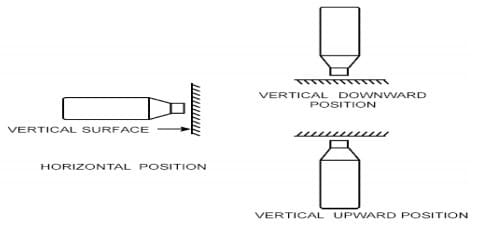Procedure for rebound hammer test on concrete structure starts with calibration of the rebound hammer. For this, the rebound hammer is tested against the test anvil made of steel having Brinell hardness number of about 5000 N/mm2.
After the rebound hammer is tested for accuracy on the test anvil, the rebound hammer is held at right angles to the surface of the concrete structure for taking the readings. The test thus can be conducted horizontally on vertical surface and vertically upwards or downwards on horizontal surfaces as shown in figure below:


Fig: Rebound Hammer Positions for Testing Concrete Structure
If the rebound hammer is held at intermediate angle, the rebound number will be different for the same concrete.
The following points should be observed during testing.
(a) The concrete surface should be smooth, clean and dry.
(b) Ant loose particles should be rubbed off from the concrete surface with a grinding wheel or stone, before hammer testing.
(c) Rebound hammer test should not be conducted on rough surfaces as a result of incomplete compaction, loss of grout, spalled or tooled concrete surface.
(d) The point of impact of rebound hammer on concrete surface should be at least 20mm away from edge or shape discontinuity.
Six readings of rebound number is taken at each point of testing and an average of value of the readings is taken as rebound index for the corresponding point of observation on concrete surface.
How the correlation between compressive strength of concrete and rebound number is obtained:
The most suitable method of obtaining the correlation between compressive strength of concrete and rebound number is to test the concrete cubes using compression testing machine as well as using rebound hammer simultaneously. First the rebound number of concrete cube is taken and then the compressive strength is tested on compression testing machine. The fixed load required is of the order of 7 N/ mm2when the impact energy of the hammer is about 2.2 Nm. The load should be increased for calibrating rebound hammers of greater impact energy and decreased for calibrating rebound hammers of lesser impact energy. The test specimens should be as large a mass as possible in order to minimize the size effect on the test result of a full scale structure. 150mm cube specimens are preferred for calibrating rebound hammers of lower impact energy (2.2Nm), whereas for rebound hammers of higher impact energy, for example 30 Nm, the test cubes should not be smaller than 300mm.
The concrete cube specimens should be kept at room temperature for about 24 hours after taking it out from the curing pond, before testing it with the rebound hammer. To obtain a correlation between rebound numbers and strength of wet cured and wet tested cubes, it is necessary to establish a correlation between the strength of wet tested cubes and the strength of dry tested cubes on which rebound readings are taken. A direct correlation between rebound numbers on wet cubes and the strength of wet cubes is not recommended. Only the vertical faces of the cubes as cast should be tested. At least nine readings should be taken on each of the two vertical faces accessible in the compression testing machine when using the rebound hammers. The points of impact on the specimen must not be nearer an edge than 20mm and should be not less than 20mm from each other. The same points must not be impacted more than once.
Interpretation of Rebound Hammer Test Results:
After obtaining the correlation between compressive strength and rebound number, the strength of structure can be assessed. In general, the rebound number increases as the strength increases and is also affected by a number of parameters i.e. type of cement, type of aggregate, surface condition and moisture content of the concrete, curing and age of concrete, carbonation of concrete surface etc. Moreover the rebound index is indicative of compressive strength of concrete up to a limited depth from the surface. The internal cracks, flaws etc. or heterogeneity across the cross section will not be indicated by rebound numbers.
As such the estimation of strength of concrete by rebound hammer method cannot be held to be very accurate and probable accuracy of prediction of concrete strength in a structure is ± 25 percent. If the relationship between rebound index and compressive strength can be found by tests on core samples obtained from the structure or standard specimens made with the same concrete materials and mix proportion, then the accuracy of results and confidence thereon gets greatly increased.